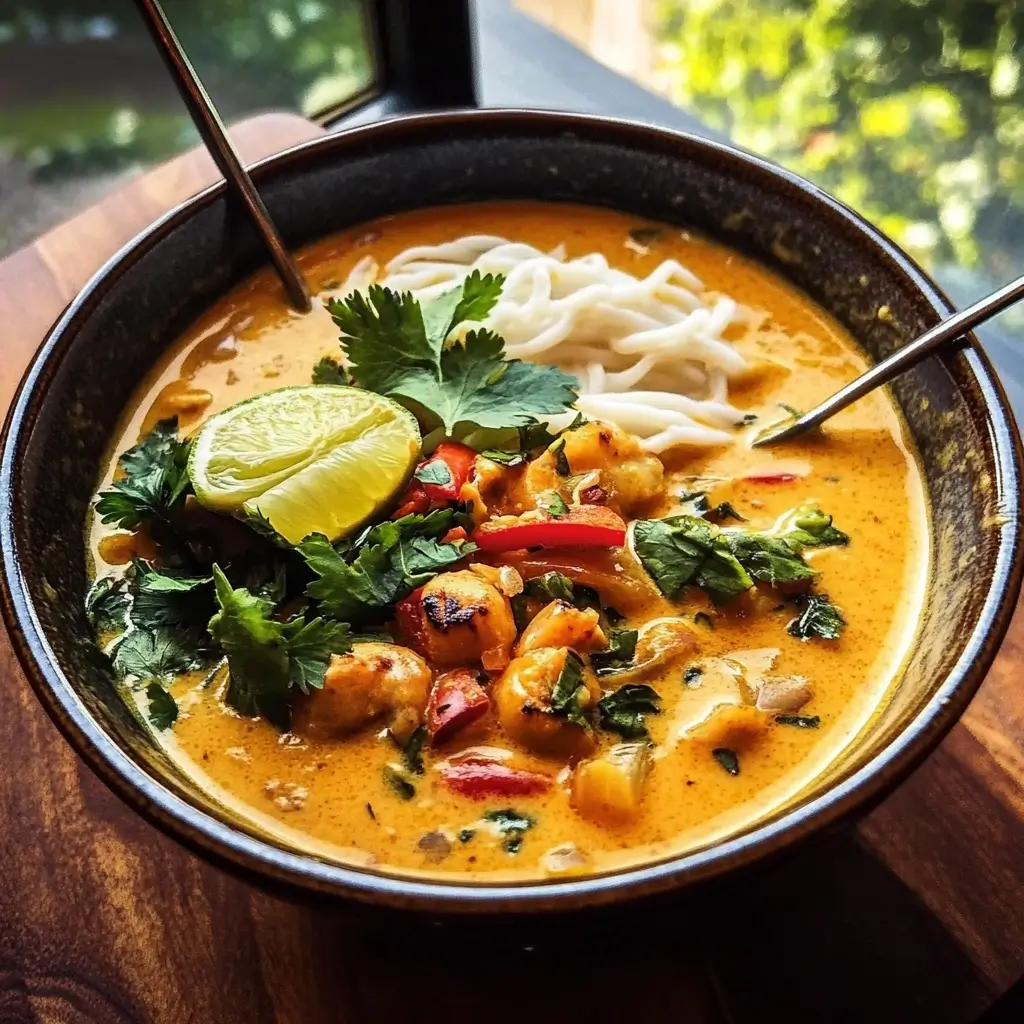It’s funny how some dishes just have a way of instantly transporting you. For me, Thai Coconut Curry Soup is one of those magical recipes. The first time I made it at home, the aroma alone filled my kitchen with an exotic warmth that chased away a dreary winter day. My family, usually a tough crowd to please when it comes to trying new things, devoured it. Even my youngest, who typically shies away from anything remotely “spicy,” couldn’t get enough of the creamy, flavorful broth and tender vegetables. It’s become a regular request in our house, and I’ve tweaked and perfected it over time to be the absolute best version – a comforting, vibrant, and surprisingly easy meal that always feels like a special treat. Whether you’re a seasoned cook or just starting out, this Thai Coconut Curry Soup recipe is a guaranteed crowd-pleaser that will bring a taste of Thailand right to your table.
Ingredients for Thai Coconut Curry Soup
This vibrant soup is built upon layers of flavor, starting with fresh, aromatic ingredients and culminating in a rich, creamy, and slightly spicy broth. Here’s what you’ll need to create this culinary masterpiece:
- Coconut Milk: The heart and soul of this soup, full-fat coconut milk provides the signature creamy texture and rich coconut flavor. It creates the luscious base that carries all the other delicious flavors.
- Chicken Broth (or Vegetable Broth for Vegetarian/Vegan): A flavorful broth forms the liquid foundation of the soup, adding depth beyond just water. Chicken broth lends a savory richness, while vegetable broth keeps it light and vegetarian-friendly.
- Red Curry Paste: This is the spice powerhouse! Red curry paste is a blend of chilies, garlic, lemongrass, galangal, and other aromatics, providing the characteristic Thai curry flavor and a gentle heat. Adjust the amount to control the spiciness.
- Chicken Breast (or Tofu/Shrimp/Vegetables for Alternatives): Protein adds substance and makes this soup a satisfying meal. Chicken breast is a classic choice, but tofu, shrimp, or extra vegetables like mushrooms and broccoli florets work beautifully for vegetarian or pescatarian options.
- Bell Peppers (Red and Yellow): These add sweetness, color, and a slight crunch to the soup. Their vibrant hues also make the dish visually appealing.
- Onion: A foundational aromatic, onion provides a savory base note and deepens the overall flavor profile of the soup.
- Mushrooms (Shiitake or Cremini): Mushrooms bring an earthy, umami flavor and a meaty texture to the soup, complementing the other vegetables and protein.
- Ginger: Fresh ginger adds a warm, spicy, and slightly citrusy zing that is essential to authentic Thai flavors. It brightens the soup and aids digestion.
- Garlic: Another aromatic staple, garlic provides a pungent and savory depth of flavor that melds beautifully with the other spices and ingredients.
- Lime Juice: Fresh lime juice adds a crucial element of acidity, balancing the richness of the coconut milk and brightening all the flavors just before serving. It’s the finishing touch that makes everything pop.
- Fish Sauce (or Soy Sauce/Tamari for Vegetarian/Vegan): Fish sauce provides a salty, umami-rich depth of flavor that is characteristic of Thai cuisine. Soy sauce or tamari offer a vegetarian/vegan alternative, adding saltiness and umami notes.
- Brown Sugar (or Palm Sugar/Honey/Maple Syrup): A touch of sweetness balances the savory and spicy elements of the soup. Brown sugar provides a subtle molasses note, while other sweeteners can be used as alternatives.
- Cilantro (Fresh): Fresh cilantro adds a bright, herbaceous, and slightly citrusy flavor as a garnish, completing the flavor profile and adding a pop of fresh green color.
- Green Onions (Scallions): Sliced green onions provide a mild oniony flavor and a fresh, crisp texture as a garnish, enhancing the visual appeal and flavor of the soup.
- Vegetable Oil (or Coconut Oil): Used for sautéing the aromatics and vegetables, vegetable oil is neutral in flavor, while coconut oil can enhance the coconut theme of the soup.
Instructions for Making Thai Coconut Curry Soup
Creating this flavorful Thai Coconut Curry Soup is surprisingly straightforward. Follow these simple steps to bring this delicious dish to life in your own kitchen:
- Prepare the Aromatics and Vegetables: Begin by prepping your ingredients. Finely chop the onion, mince the garlic and ginger, and slice the bell peppers and mushrooms. If using chicken, cut it into bite-sized pieces. If using tofu, press it to remove excess water and cube it. Having everything prepped and ready to go will make the cooking process smoother and faster. Properly prepping your vegetables ensures even cooking and releases their flavors effectively during the sautéing process.
- Sauté the Aromatics: Heat the vegetable oil (or coconut oil) in a large pot or Dutch oven over medium heat. Add the chopped onion and sauté for about 3-5 minutes, or until it becomes softened and translucent. Then, add the minced garlic and ginger to the pot and sauté for another minute until fragrant. Be careful not to burn the garlic and ginger, as this can impart a bitter taste. Sautéing these aromatics first releases their essential oils, building a flavorful base for the curry.
- Add Curry Paste and Bloom: Stir in the red curry paste to the pot and sauté for about 1-2 minutes. This process, known as “blooming” the spices, helps to release their full aroma and flavor potential. Stir constantly to prevent the curry paste from sticking to the bottom of the pot and burning. The fragrance will become more intense as the curry paste heats up, indicating it’s ready.
- Incorporate Protein (Chicken/Tofu/Shrimp): If using chicken, add the bite-sized pieces to the pot and cook until they are lightly browned on the outside. If using tofu, add the cubed tofu and lightly brown it as well. If using shrimp, you can add them later in the process as they cook quickly. Searing the protein adds another layer of flavor and texture to the soup. If using vegetables only, you can skip this step and move directly to adding the other vegetables.
- Add Vegetables and Broth: Add the sliced bell peppers and mushrooms to the pot and cook for about 5-7 minutes, or until they begin to soften slightly. Pour in the chicken broth (or vegetable broth) and bring the mixture to a simmer. Simmering allows the flavors to meld together and the vegetables to cook through without becoming mushy.
- Stir in Coconut Milk and Seasonings: Reduce the heat to low and stir in the full-fat coconut milk. Add the fish sauce (or soy sauce/tamari), brown sugar (or your chosen sweetener), and lime juice. Stir well to combine all the ingredients and seasonings. Taste the soup and adjust seasonings as needed. You might want to add more red curry paste for extra heat, more lime juice for acidity, or more fish sauce/soy sauce for saltiness.
- Simmer and Finish: Let the soup simmer gently for about 10-15 minutes to allow the flavors to fully develop and deepen. If you are using shrimp, add them during the last 5 minutes of simmering as they cook quickly. Avoid boiling the soup vigorously after adding coconut milk, as this can cause it to separate. Simmering gently ensures a creamy and well-integrated soup.
- Serve and Garnish: Ladle the Thai Coconut Curry Soup into bowls. Garnish generously with fresh cilantro and sliced green onions. Serve hot and enjoy the explosion of flavors! You can also add a squeeze of extra lime juice just before serving for an extra burst of freshness.
Nutrition Facts for Thai Coconut Curry Soup (per serving, approximate)
This Thai Coconut Curry Soup is not only delicious but can also be a relatively healthy and balanced meal, depending on the ingredients and portion sizes. Here are approximate nutrition facts per serving (assuming a recipe serving 6 and using chicken breast and moderate oil):
- Calories: Approximately 350-450 calories per serving. This is a moderate calorie count, making it a satisfying meal without being overly heavy. The exact calorie count will depend on the specific ingredients and portion sizes.
- Protein: Around 25-35 grams of protein per serving. Protein from chicken (or tofu/shrimp) helps promote satiety and is essential for muscle building and repair. This makes it a substantial and filling soup.
- Fat: Approximately 20-30 grams of fat per serving. The fat primarily comes from the coconut milk, which is rich in saturated fat. While saturated fat should be consumed in moderation, coconut milk also contains medium-chain triglycerides (MCTs), which are metabolized differently by the body. The fat contributes to the creamy texture and richness of the soup.
- Carbohydrates: Roughly 20-30 grams of carbohydrates per serving. Carbohydrates come from vegetables, coconut milk, and a small amount of sugar. These provide energy and fiber.
- Sodium: Varies significantly depending on broth and fish sauce/soy sauce used, but can range from 500-800mg per serving. Be mindful of sodium content, especially if using store-bought broth and fish sauce. You can reduce sodium by using low-sodium broth and controlling the amount of fish sauce/soy sauce.
Note: These are approximate values and can vary based on specific ingredients, brands, and portion sizes. For accurate nutritional information, use a nutrition calculator with the exact ingredients and measurements you use.
Preparation Time for Thai Coconut Curry Soup
The beauty of this Thai Coconut Curry Soup lies in its relatively quick preparation time, making it perfect for weeknight meals or when you crave a flavorful and satisfying dish without spending hours in the kitchen.
- Total Preparation Time: Approximately 30-40 minutes. This includes chopping vegetables, prepping aromatics, cooking the soup, and simmering. The majority of the time is spent on the active cooking and simmering process, but the initial prep is quite quick.
- Active Cooking Time: Around 20-25 minutes. This encompasses sautéing aromatics, blooming curry paste, cooking protein and vegetables, and simmering the soup. The active cooking time is relatively short, making it a manageable recipe even on busy days.
- Prep Time (Chopping & Measuring): Approximately 10-15 minutes. This involves chopping vegetables, mincing garlic and ginger, measuring ingredients, and getting everything ready for cooking. Efficiently prepping ingredients beforehand streamlines the cooking process and saves time.
Overall, from start to finish, you can have a steaming bowl of delicious Thai Coconut Curry Soup on your table in under 40 minutes! This makes it a fantastic option for a flavorful and healthy meal that doesn’t require a huge time commitment.
How to Serve Thai Coconut Curry Soup
Thai Coconut Curry Soup is a versatile dish that can be served in numerous ways, making it a delightful meal on its own or as part of a larger Thai feast. Here are some serving suggestions to elevate your dining experience:
- Serve Hot: Thai Coconut Curry Soup is best enjoyed hot, allowing the aromatic steam to release its full fragrance and the flavors to be at their peak.
- Garnish Generously: Fresh garnishes are crucial for adding brightness and freshness to the soup.
- Fresh Cilantro: A must-have garnish, adding a vibrant, herbaceous note.
- Sliced Green Onions (Scallions): Provide a mild oniony flavor and crisp texture.
- Lime Wedges: Offer extra lime wedges on the side so diners can add a squeeze of fresh lime juice to their individual bowls for an extra burst of acidity and freshness.
- Red Pepper Flakes (Optional): For those who like extra heat, a sprinkle of red pepper flakes can add a fiery kick.
- Toasted Sesame Seeds (Optional): Add a nutty flavor and visual appeal.
- Serve with Rice: Steamed rice is a classic accompaniment to Thai curry soups.
- Jasmine Rice: Its fragrant aroma and slightly sticky texture pair perfectly with the creamy soup.
- Brown Rice: For a healthier option with more fiber and a nutty flavor.
- Serve with Noodles (Optional): For a heartier meal, you can add noodles to the soup.
- Rice Noodles: Flat rice noodles or vermicelli rice noodles are excellent choices and stay true to Thai cuisine.
- Glass Noodles (Bean Thread Noodles): These thin, transparent noodles add a delicate texture and absorb the flavorful broth beautifully.
- Serve as a Starter or Main Course:
- Starter: Serve smaller portions of the soup as a flavorful and light starter before a main course of other Thai dishes.
- Main Course: Serve larger portions as a satisfying and complete main course, especially when paired with rice or noodles.
- Serve with Side Dishes (for a Thai Feast): Create a complete Thai meal by serving the soup alongside other Thai dishes such as:
- Spring Rolls or Summer Rolls: Fresh and crispy appetizers.
- Thai Salad (e.g., Papaya Salad): Offers a refreshing and spicy contrast to the creamy soup.
- Stir-fried Vegetables or Meat Dishes: Provide variety and balance to the meal.
Additional Tips for the Best Thai Coconut Curry Soup
To truly master Thai Coconut Curry Soup and make it your own, consider these helpful tips and tricks:
- Quality of Coconut Milk Matters: Opt for full-fat coconut milk for the richest and creamiest texture. Canned coconut milk is readily available and works perfectly. Avoid “lite” coconut milk as it will result in a thinner and less flavorful soup. The richness of full-fat coconut milk is essential for the authentic creamy texture and flavor.
- Adjust the Spice Level to Your Preference: Red curry paste comes in varying levels of spiciness. Start with a smaller amount (e.g., 1-2 tablespoons) and taste as you go, adding more to reach your desired heat level. You can also add a pinch of chili flakes for extra heat if needed. Knowing your spice tolerance and starting conservatively is key to enjoying the soup comfortably.
- Don’t Boil After Adding Coconut Milk: Once you add the coconut milk, reduce the heat to low and gently simmer the soup. Boiling coconut milk can cause it to separate and lose its creamy texture. Gentle simmering ensures a smooth and emulsified soup.
- Fresh Ingredients for Maximum Flavor: Whenever possible, use fresh ingredients like ginger, garlic, lemongrass (if available), cilantro, and lime juice. Fresh ingredients provide a brighter and more vibrant flavor compared to dried or powdered alternatives. The freshness of aromatics and herbs significantly impacts the overall taste of the soup.
- Balance the Flavors: Thai cuisine is all about balancing sweet, sour, salty, and spicy flavors. Taste and adjust the seasoning as you cook. You might need to add more lime juice for acidity, fish sauce/soy sauce for saltiness, or sugar for sweetness to achieve the perfect balance. Regular tasting and adjusting seasonings is crucial for achieving a well-rounded and delicious flavor profile.
- Customize with Your Favorite Vegetables and Protein: Feel free to adapt the recipe to your liking by adding different vegetables such as broccoli florets, snap peas, carrots, bamboo shoots, or baby corn. You can also use different proteins like shrimp, tofu, beef, or pork, or keep it vegetarian by adding more vegetables or beans. The recipe is highly adaptable to personal preferences and dietary needs.
- Make it Vegetarian or Vegan: Easily make this soup vegetarian or vegan by using vegetable broth instead of chicken broth, substituting tofu or extra vegetables for chicken, and using soy sauce or tamari instead of fish sauce. Ensure the red curry paste you use is also vegetarian/vegan, as some may contain shrimp paste. These simple substitutions allow for a delicious and ethical vegetarian/vegan version.
- Make Ahead and Store Well: Thai Coconut Curry Soup is a great make-ahead meal. It actually tastes even better the next day as the flavors meld together. Store leftover soup in an airtight container in the refrigerator for up to 3-4 days. Reheat gently on the stovetop or in the microwave. This makes it perfect for meal prepping or enjoying leftovers for lunch or dinner.
Frequently Asked Questions (FAQ) about Thai Coconut Curry Soup
Curious to know more about Thai Coconut Curry Soup? Here are some frequently asked questions to help you understand and perfect this delightful dish:
Q1: What is Thai Coconut Curry Soup, and is it authentic Thai food?
A: Thai Coconut Curry Soup, often referred to as Tom Kha Gai (if made with chicken), is a popular and beloved Thai soup characterized by its creamy coconut milk base, aromatic spices, and a balance of sweet, sour, salty, and spicy flavors. While variations exist, and “authenticity” can be debated, it’s inspired by traditional Thai flavors and cooking techniques, capturing the essence of Thai cuisine. It is a widely recognized and enjoyed dish both in Thailand and internationally.
Q2: Can I make Thai Coconut Curry Soup spicier?
A: Absolutely! You can easily adjust the spice level to your preference. Increase the amount of red curry paste you use. Add a pinch of red pepper flakes or a finely chopped Thai chili pepper to the soup while cooking. You can also serve it with a side of chili oil or Sriracha for those who prefer extra heat. Start with a moderate amount of curry paste and add more gradually, tasting as you go.
Q3: Can I use light coconut milk instead of full-fat coconut milk?
A: While you can use light coconut milk for a lower-fat version, it is highly recommended to use full-fat coconut milk for the best flavor and creamy texture. Light coconut milk will result in a thinner and less rich soup. If using light coconut milk, you might consider adding a touch of coconut cream or a thickener like cornstarch slurry to improve the texture. Full-fat coconut milk is a key ingredient for the characteristic richness and creaminess of the soup.
Q4: What if I don’t like fish sauce? Can I substitute it?
A: Yes, you can definitely substitute fish sauce. Soy sauce or tamari (for gluten-free) are excellent vegetarian/vegan alternatives that provide a similar salty and umami depth. You can also use coconut aminos or even just a pinch of salt, but soy sauce or tamari will be the closest in flavor profile. Fish sauce adds a distinct umami flavor, but soy sauce/tamari are good substitutes.
Q5: Can I freeze Thai Coconut Curry Soup?
A: Yes, you can freeze Thai Coconut Curry Soup, but the texture of the coconut milk might slightly change upon thawing. It’s best to freeze it without the garnishes. Let the soup cool completely before transferring it to freezer-safe containers. Thaw overnight in the refrigerator and reheat gently on the stovetop or in the microwave. Freezing is a good option for longer storage, but be aware of potential texture changes.
Q6: What are some good vegetarian protein options for this soup?
A: Tofu (firm or extra-firm) is a fantastic vegetarian protein option that absorbs the flavors of the soup beautifully. Other great choices include chickpeas, white beans, edamame, or lentils. You can also add more vegetables like broccoli, cauliflower, or spinach to make it a hearty vegetarian meal. Vegetarian protein options add substance and make the soup a complete meal.
Q7: Can I make this soup ahead of time? Does it taste better the next day?
A: Absolutely! Thai Coconut Curry Soup is an excellent make-ahead dish. In fact, many believe it tastes even better the next day as the flavors have more time to meld and deepen. Prepare the soup a day or two in advance and store it in the refrigerator. Reheat gently before serving. Making it ahead is convenient and often enhances the flavor.
Q8: Where can I find red curry paste?
A: Red curry paste is widely available in most supermarkets in the international or Asian food aisle. You can also find it at Asian grocery stores or online retailers. Look for reputable brands like Mae Ploy, Thai Kitchen, or Aroy-D. Red curry paste is a readily accessible ingredient in most grocery stores.

Thai Coconut Curry Soup
- Total Time: 1 hour 5 minutes
Ingredients
This vibrant soup is built upon layers of flavor, starting with fresh, aromatic ingredients and culminating in a rich, creamy, and slightly spicy broth. Here’s what you’ll need to create this culinary masterpiece:
- Coconut Milk: The heart and soul of this soup, full-fat coconut milk provides the signature creamy texture and rich coconut flavor. It creates the luscious base that carries all the other delicious flavors.
- Chicken Broth (or Vegetable Broth for Vegetarian/Vegan): A flavorful broth forms the liquid foundation of the soup, adding depth beyond just water. Chicken broth lends a savory richness, while vegetable broth keeps it light and vegetarian-friendly.
- Red Curry Paste: This is the spice powerhouse! Red curry paste is a blend of chilies, garlic, lemongrass, galangal, and other aromatics, providing the characteristic Thai curry flavor and a gentle heat. Adjust the amount to control the spiciness.
- Chicken Breast (or Tofu/Shrimp/Vegetables for Alternatives): Protein adds substance and makes this soup a satisfying meal. Chicken breast is a classic choice, but tofu, shrimp, or extra vegetables like mushrooms and broccoli florets work beautifully for vegetarian or pescatarian options.
- Bell Peppers (Red and Yellow): These add sweetness, color, and a slight crunch to the soup. Their vibrant hues also make the dish visually appealing.
- Onion: A foundational aromatic, onion provides a savory base note and deepens the overall flavor profile of the soup.
- Mushrooms (Shiitake or Cremini): Mushrooms bring an earthy, umami flavor and a meaty texture to the soup, complementing the other vegetables and protein.
- Ginger: Fresh ginger adds a warm, spicy, and slightly citrusy zing that is essential to authentic Thai flavors. It brightens the soup and aids digestion.
- Garlic: Another aromatic staple, garlic provides a pungent and savory depth of flavor that melds beautifully with the other spices and ingredients.
- Lime Juice: Fresh lime juice adds a crucial element of acidity, balancing the richness of the coconut milk and brightening all the flavors just before serving. It’s the finishing touch that makes everything pop.
- Fish Sauce (or Soy Sauce/Tamari for Vegetarian/Vegan): Fish sauce provides a salty, umami-rich depth of flavor that is characteristic of Thai cuisine. Soy sauce or tamari offer a vegetarian/vegan alternative, adding saltiness and umami notes.
- Brown Sugar (or Palm Sugar/Honey/Maple Syrup): A touch of sweetness balances the savory and spicy elements of the soup. Brown sugar provides a subtle molasses note, while other sweeteners can be used as alternatives.
- Cilantro (Fresh): Fresh cilantro adds a bright, herbaceous, and slightly citrusy flavor as a garnish, completing the flavor profile and adding a pop of fresh green color.
- Green Onions (Scallions): Sliced green onions provide a mild oniony flavor and a fresh, crisp texture as a garnish, enhancing the visual appeal and flavor of the soup.
- Vegetable Oil (or Coconut Oil): Used for sautéing the aromatics and vegetables, vegetable oil is neutral in flavor, while coconut oil can enhance the coconut theme of the soup.
Instructions
Creating this flavorful Thai Coconut Curry Soup is surprisingly straightforward. Follow these simple steps to bring this delicious dish to life in your own kitchen:
- Prepare the Aromatics and Vegetables: Begin by prepping your ingredients. Finely chop the onion, mince the garlic and ginger, and slice the bell peppers and mushrooms. If using chicken, cut it into bite-sized pieces. If using tofu, press it to remove excess water and cube it. Having everything prepped and ready to go will make the cooking process smoother and faster. Properly prepping your vegetables ensures even cooking and releases their flavors effectively during the sautéing process.
- Sauté the Aromatics: Heat the vegetable oil (or coconut oil) in a large pot or Dutch oven over medium heat. Add the chopped onion and sauté for about 3-5 minutes, or until it becomes softened and translucent. Then, add the minced garlic and ginger to the pot and sauté for another minute until fragrant. Be careful not to burn the garlic and ginger, as this can impart a bitter taste. Sautéing these aromatics first releases their essential oils, building a flavorful base for the curry.
- Add Curry Paste and Bloom: Stir in the red curry paste to the pot and sauté for about 1-2 minutes. This process, known as “blooming” the spices, helps to release their full aroma and flavor potential. Stir constantly to prevent the curry paste from sticking to the bottom of the pot and burning. The fragrance will become more intense as the curry paste heats up, indicating it’s ready.
- Incorporate Protein (Chicken/Tofu/Shrimp): If using chicken, add the bite-sized pieces to the pot and cook until they are lightly browned on the outside. If using tofu, add the cubed tofu and lightly brown it as well. If using shrimp, you can add them later in the process as they cook quickly. Searing the protein adds another layer of flavor and texture to the soup. If using vegetables only, you can skip this step and move directly to adding the other vegetables.
- Add Vegetables and Broth: Add the sliced bell peppers and mushrooms to the pot and cook for about 5-7 minutes, or until they begin to soften slightly. Pour in the chicken broth (or vegetable broth) and bring the mixture to a simmer. Simmering allows the flavors to meld together and the vegetables to cook through without becoming mushy.
- Stir in Coconut Milk and Seasonings: Reduce the heat to low and stir in the full-fat coconut milk. Add the fish sauce (or soy sauce/tamari), brown sugar (or your chosen sweetener), and lime juice. Stir well to combine all the ingredients and seasonings. Taste the soup and adjust seasonings as needed. You might want to add more red curry paste for extra heat, more lime juice for acidity, or more fish sauce/soy sauce for saltiness.
- Simmer and Finish: Let the soup simmer gently for about 10-15 minutes to allow the flavors to fully develop and deepen. If you are using shrimp, add them during the last 5 minutes of simmering as they cook quickly. Avoid boiling the soup vigorously after adding coconut milk, as this can cause it to separate. Simmering gently ensures a creamy and well-integrated soup.
- Serve and Garnish: Ladle the Thai Coconut Curry Soup into bowls. Garnish generously with fresh cilantro and sliced green onions. Serve hot and enjoy the explosion of flavors! You can also add a squeeze of extra lime juice just before serving for an extra burst of freshness.
- Prep Time: 40 minutes
- Cook Time: 25 minutes
Nutrition
- Serving Size: one normal portion
- Calories: 450
- Sodium: 800mg
- Fat: 30
- Carbohydrates: 30
- Protein: 35






